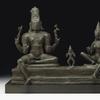Jades from China’s Ancient Kingdoms
- September 16, 2010 12:10
The Norton Museum or Art's Chinese galleries present a fascinating array of expertly crafted jade objects ranging from prehistory to the eighteenth century.
The long span of production – up to 7,000 years by some estimates – indicates the significance jade possessed among the inhabitants of China’s earliest cultures, as well as the resonance of the material and its meanings throughout Chinese history.
In the Meyer Gallery on the Museum’s second floor, some of the earliest jade forms are based upon utilitarian blades (such as the ceremonial blade known as a zhang). Others, in the form of animals, have holes drilled through them so they could be worn as pendants. Still others, like the Museum’s disc called a bi (pr. “bee”) and the prismatic tubes called cong (pr. “tsong”) appear unlike anything in the European artistic tradition.
Yu is the Chinese word for grey, green, white, brown, or black hardstones, and in the Chinese language, yu is also associated with spiritual power and beauty. When translated into English as “jade,” the term refers to two minerals: nephrite and jadite. The second of these was not known in China before the 18th century. Nephrite, however, has been “harvested” for centuries along rivers in the western provinces of China. Since it is unlikely that pre-historic inhabitants near modern Shanghai had access to these distant sources, archaeologists assumed that these ancient people located and exhausted sources of nephrite closer to the Yellow Sea. The recent discovery of jade deposits in eastern China has confirmed that assumption.
Archaeologists believe that jade became the most important material for the expression of beliefs and status in prehistoric China between 3500 and 2000 bce. Since Neolithic cultures did not leave written records, archaeologists have combed ancient cultural sites for evidence of the inhabitants’ uses for, and beliefs about jade. What they have discovered are sophisticated ceremonial and burial sites of elites that include a variety of jade, ceramic, stone and lacquer objects.
In tombs of the Neolithic Liangzhu culture (near modern Shanghai) bi and cong were deposited with the deceased. Some nobles and their family members were buried with over 100 jades; lacquer and ceramic objects were placed at the feet of the deceased, while jades were placed around and on top of the body. During the Shang dynasty (1500-1050 bce), bronze challenged the pre-eminence of jade in the production of status and tomb goods, but objects crafted from the mineral remained supremely important. The beautiful examples of bi and cong in the Norton collection testify to the ongoing importance of these ancient forms through the Shang and Zhou dynasties when many of the bronzes on view in the collection were also produced.
The hardness of jade – 6 to 6.5 on the Mohs’ scale - makes it impossible to cut with metal tools. Instead, jade had to be fashioned using abrasive sand and straight-edged or gut string saws. Sticks of bamboo may have been used as a drill with abrasives, and flint tools may have been used for scratching the fine details on the jades’ surfaces. Consider these limited tools as you look at the precise contours and inscribed features of the cong, bi or the animal pendants on display.
The hundreds of hours of dedicated labor that was invested in the production of a single jade object implies a sophisticated culture in which: a ruling elite had access to resources through control of land and manpower or through trade; a highly-skilled labor force could be trained and maintained to produce these objects; ritual objects were used to help define the beliefs, power and status of the ruling class.




















